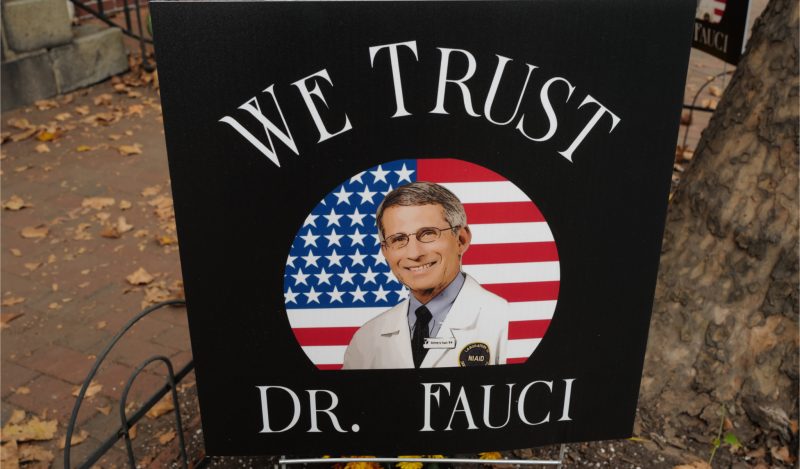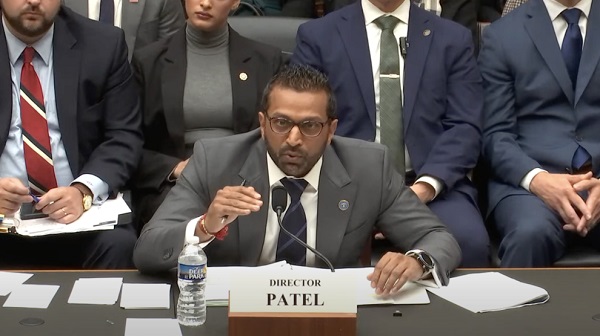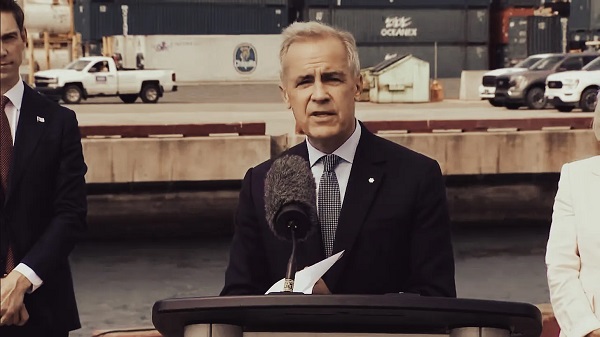Brownstone Institute
Anthony Fauci’s Very Bad Week

From the Brownstone Institute
BY
It’s not been Anthony Fauci’s best week.
Forever intent on managing his image and public opinion on the pandemic response, he accepted a seemingly safe interview on CNN. The reporter was someone he trusted, Michael Smerconish, who tossed in what he believed to be a softball question.
He asked Fauci about the Cochrane study on masks by Tom Jefferson, and, in particular the author’s comments to Brownstone fellow Maryanne Demasi. Jefferson flat out said that masks don’t work to control viruses. Smerconish simply wanted Fauci’s response.
Fauci, who might have been expected to perform better, stumbled very badly. He said that while on a population level mask evidence is weak, the evidence is stronger on an individual level. That of course is a bit of a head-scratcher, especially since he cited none of the supposed studies.
Actually, it makes no sense at all. The whole point of the Jefferson paper was to examine the best-possible evidence. The results were exactly the “science” that Fauci has touted for years. The big difference is that the results completely contradict Fauci himself. Is this guy a pathological liar?
You can watch the snippet:
CNN's @smerconish confronts Dr. Fauci with the latest evidence that masks, even N95s, made "no difference" in the pandemic. Fauci responds by basically conceding that point while adding the nonsensical claim that masks work on an "individual basis," or something.
Smerconish ends… pic.twitter.com/tZB62saxOL
— Scott Morefield (@SKMorefield) September 3, 2023
After the exchange, Smerconish reported that he texted Fauci an apology for the way the interview went, assuring him that it was not intended as a “gotcha” interview. He reported that Fauci texted him back but didn’t want to share the contents because he didn’t have permission. Interesting. I’m pretty sure that a reporter under normal circumstances would certainly share that information. But as we know, Fauci is in a league of his own.
In addition, some very interesting email correspondence came out, thanks to a FOIA request by US Right to Know. The communication to Fauci was courtesy of Fauci’s chief of staff Greg Folkers and on behalf of Fauci’s frequent co-author David Morens. The date was January 27, 2020, about the time that China’s experience with SARS-CoV-2 was making the news all over the US. (I wrote my first article against lockdowns for Covid the next day.)
“EcoHealth group (Peter Daszak et al), has for years been among the biggest players in coronavirus work, also in collaboration with Ralph Baric, Ian Lipkin and others,” wrote Folkers. In the past 5 years, and working with the Wuhan Institute of Virology, they had discovered hundreds of coronaviruses circulating in China. Further, the memo said, “clinical signs of bat SARS-CoVs in mice were not prevented with a vaccine candidate against SARS-CoV, and were not treatable with most monoclonal therapies being developed.”
Here is the full memo:
 The timing here checks out against Jeremy Farrar’s own memoir:
The timing here checks out against Jeremy Farrar’s own memoir:
“By the second week of January, I was beginning to realise the scale of what was happening. I was also getting the uncomfortable feeling that some of the information needed by scientists all around the world to detect and fight this new disease was not being disclosed as fast as it could be. I did not know it then, but a fraught few weeks lay ahead. In those weeks, I became exhausted and scared. I felt as if I was living a different person’s life. During that period, I would do things I had never done before: acquire a burner phone, hold clandestine meetings, keep difficult secrets. I would have surreal conversations with my wife, Christiane, who persuaded me we should let the people closest to us know what was going on. I phoned my brother and best friend to give them my temporary number. In hushed conversations, I sketched out the possibility of a looming global health crisis that had the potential to be read as bioterrorism. ‘If anything happens to me in the next few weeks,’ I told them nervously, ‘this is what you need to know.’”
Wow, these guys believed they would be off’d! That’s some crazy stuff there.
These weeks were the critical turning point. China had already locked down. Farrar reports that “the world had all the information it needed by 24 January: a potentially fatal novel respiratory disease that could spread between people without symptoms, with no vaccines or treatments, that had already ravaged a huge, highly connected Chinese city.”
Then the possibility of a lab leak became very obvious in these days. “In the last week of January 2020,” he writes, “I saw email chatter from scientists in the US suggesting the virus looked almost engineered to infect human cells. These were credible scientists proposing an incredible, and terrifying, possibility of either an accidental leak from a laboratory or a deliberate release.”
This fits exactly with the above memo to Fauci. It was at this point that the cool-and-collected Fauci organized the authors of what became the “Proximal Origin” paper that denied it was a lab leak, the first draft of which was circulated on February 4. Among the authors was a virologist who had worked with EcoHealth.
You can look through the entire timeline and see that this all checks out. It seems ever clearer what was going on here. Fauci and his cohorts were alerted to NIH funding of the Wuhan lab. They became convinced of the very strong likelihood that this was a lab leak, accidental or deliberate. This began to make some sense of other reports from many months earlier of sick soldiers returning from the Military World Games. They panicked and they worked on a cover-up.
Why did they panic? Was it for fear of the public health consequences of a rapidly spreading virus? More likely, they panicked that they would rightly be blamed for it because the lab was funded through a third party by US taxpayers. They must also have known that they were doing gain-of-function research: the idea that labs create viruses and then also manufacture the antidote in the form of a vaccine. But according to the report on Fauci’s desk, no vaccine works for this one or others in this class of virus.
Fauci defaulted to the only action he could think of at the time: use lockdowns to minimize the spread. His staff had already taken a junket to Wuhan and returned with a report dated February 24, 2020 that said that lockdowns worked to suppress viral spread.
Lacking any better ideas, Fauci decided to push lockdowns as a way of minimizing the damage and keeping his reputation out of harm’s way by 1) denying the lab leak with a seemingly credible paper, and 2) causing a hugely distracting amount of chaos with a lockdown that they convinced Donald Trump himself to back.
This would of course wreck the Trump presidency, which was a bonus from the point of view of the military intelligence that was already working to implement protocols from their recently concluded “germ games.”
Next in line came the necessity to involve the New York Times, which on February 28 ran an article calling for the US to “go medieval” on the virus in addition to an article by Peter Dazsak himself on the op-ed page!
Four days later, Fauci told Michael Gerson of the Washington Post on March 2, 2020, that no vaccine would be needed to get over the pandemic. “Social distancing is not really geared to wait for a vaccine,” wrote Fauci. “The epidemic will gradually decline and stop on its own without a vaccine.”
Why would he say this? Again, Fauci had been told that no vaccine in China seemed to work. Plus, he is not a stupid man – coronaviruses mutate too quickly – and had years of attempts to vaccinate against AIDS without success. So his thinking was that using force to stop the spread was the only real option for a man who was seeking to “cover his ass,” as the expression goes.
The big problem with the plan, of course, was that there was no exit strategy. As soon as you open up, the virus is going to spread anyway. This was why Fauci welcomed all attempts at creating a vaccine anyway. At least the vaccine would provide an excuse to end the lockdowns.
But just in case it did not, he worked with his co-author David Morens on a big think piece that came out in Cell in August 2020. This was the paper that said lockdowns should really be permanent.
“Living in greater harmony with nature,” they wrote, “will require changes in human behavior as well as other radical changes that may take decades to achieve: rebuilding the infrastructures of human existence, from cities to homes to workplaces, to water and sewer systems, to recreational and gatherings venues.”
Despite Fauci’s wishes, the most extreme aspects of lockdowns gradually faded away in time, most anointed experts can pretend as if the vaccine ended the worst aspects of the pandemic (that’s why the mandates became necessary, if only to maximize uptake and confound the science), and Fauci keeps going on national television, despite his age and wealth, to dial back his responsibility for any aspect of it, including the lockdowns he is on record backing from February 26, 2020, onward.
In any case, this is a summary of current knowledge. There are of course many other layers to this onion, including the early involvement of the pharmaceutical companies and the extensive intervention by the Department of Defense. Sadly, much of the necessary information to sort through that thicket is wholly classified.
Thus ends Fauci’s not-so-good week. We’ll get to the bottom of this eventually.
Author
Brownstone Institute
Net Zero: The Mystery of the Falling Fertility

From the Brownstone Institute
By
If you want to argue that a mysterious factor X is responsible for the drop in fertility, you will have to explain (1) why the factor affected only the vaccinated, and (2) why it started affecting them at about the time of vaccination.
In January 2022, the number of children born in the Czech Republic suddenly decreased by about 10%. By the end of 2022, it had become clear that this was a signal: All the monthly numbers of newborns were mysteriously low.
In April 2023, I wrote a piece for a Czech investigative platform InFakta and suggested that this unexpected phenomenon might be connected to the aggressive vaccination campaign that had started approximately 9 months before the drop in natality. Denik N – a Czech equivalent of the New York Times – immediately came forward with a “devastating takedown” of my article, labeled me a liar and claimed that the pattern can be explained by demographics: There were fewer women in the population and they were getting older.
To compare fertility across countries (and time), the so-called Total Fertility Rate (TFR) is used. Roughly speaking, it is the average number of children that are born to a woman over her lifetime. TFR is independent of the number of women and of their age structure. Figure 1 below shows the evolution of TFR in several European countries between 2001 and 2023. I selected countries that experienced a similar drop in TFR in 2022 as the Czech Republic.

So, by the end of 2023, the following two points were clear:
- The drop in natality in the Czech Republic in 2022 could not be explained by demographic factors. Total fertility rate – which is independent of the number of women and their age structure – dropped sharply in 2022 and has been decreasing ever since. The data for 2024 show that the Czech TFR has decreased further to 1.37.
- Many other European countries experienced the same dramatic and unexpected decrease in fertility that started at the beginning of 2022. I have selected some of them for Figure 1 but there are more: The Netherlands, Norway, Slovakia, Slovenia, and Sweden. On the other hand, there are some countries that do not show a sudden drop in TFR, but rather a steady decline over a longer period (e.g. Belgium, France, UK, Greece, or Italy). Notable exceptions are Bulgaria, Spain, and Portugal where fertility has increased (albeit from very low numbers). The Human Fertility Project database has all the numbers.
This data pattern is so amazing and unexpected that even the mainstream media in Europe cannot avoid the problem completely. From time to time, talking heads with many academic titles appear and push one of the politically correct narratives: It’s Putin! (Spoiler alert: The war started in February 2022; however, children not born in 2022 were not conceived in 2021). It’s the inflation caused by Putin! (Sorry, that was even later). It’s the demographics! (Nope, see above, TFR is independent of the demographics).
Thus, the “v” word keeps creeping back into people’s minds and the Web’s Wild West is ripe with speculation. We decided not to speculate but to wrestle some more data from the Czech government. For many months, we were trying to acquire the number of newborns in each month, broken down by age and vaccination status of the mother. The post-socialist health-care system of our country is a double-edged sword: On one hand, the state collects much more data about citizens than an American would believe. On the other hand, we have an equivalent of the FOIA, and we are not afraid to use it. After many months of fruitless correspondence with the authorities, we turned to Jitka Chalankova – a Czech Ron Johnson in skirts – who finally managed to obtain an invaluable data sheet.
To my knowledge, the datasheet (now publicly available with an English translation here) is the only officially released dataset containing a breakdown of newborns by the Covid-19 vaccination status of the mother. We requested much more detailed data, but this is all we got. The data contains the number of births per month between January 2021 and December 2023 given by women (aged 18-39) who were vaccinated, i.e., had received at least one Covid vaccine dose by the date of delivery, and by women who were unvaccinated, i.e., had not received any dose of any Covid vaccine by the date of delivery.
Furthermore, the numbers of births per month by women vaccinated by one or more doses during pregnancy were provided. This enabled us to estimate the number of women who were vaccinated before conception. Then, we used open data on the Czech population structure by age, and open data on Covid vaccination by day, sex, and age.
Combining these three datasets, we were able to estimate the rates of successful conceptions (i.e., conceptions that led to births nine months later) by preconception vaccination status of the mother. Those interested in the technical details of the procedure may read Methods in the newly released paper. It is worth mentioning that the paper had been rejected without review in six high-ranking scientific journals. In Figure 2, we reprint the main finding of our analysis.

Figure 2 reveals several interesting patterns that I list here in order of importance:
- Vaccinated women conceived about a third fewer children than would be expected from their share of the population. Unvaccinated women conceived at about the same rate as all women before the pandemic. Thus, a strong association between Covid vaccination status and successful conceptions has been established.
- In the second half of 2021, there was a peak in the rate of conceptions of the unvaccinated (and a corresponding trough in the vaccinated). This points to rather intelligent behavior of Czech women, who – contrary to the official advice – probably avoided vaccination if they wanted to get pregnant. This concentrated the pregnancies in the unvaccinated group and produced the peak.
- In the first half of 2021, there was significant uncertainty in the estimates of the conception rates. The lower estimate of the conception rate in the vaccinated was produced by assuming that all women vaccinated (by at least one dose) during pregnancy were unvaccinated before conception. This was almost certainly true in the first half of 2021 because the vaccines were not available prior to 2021. The upper estimate was produced by assuming that all women vaccinated (by at least one dose) during pregnancy also received at least one dose before conception. This was probably closer to the truth in the second part of 2021. Thus, we think that the true conception rates for the vaccinated start close to the lower bound in early 2021 and end close to the upper bound in early 2022. Once again, we would like to be much more precise, but we have to work with what we have got.
Now that the association between Covid-19 vaccination and lower rates of conception has been established, the one important question looms: Is this association causal? In other words, did the Covid-19 vaccines really prevent women from getting pregnant?
The guardians of the official narrative brush off our findings and say that the difference is easily explained by confounding: The vaccinated tend to be older, more educated, city-dwelling, more climate change aware…you name it. That all may well be true, but in early 2022, the TFR of the whole population dropped sharply and has been decreasing ever since.
So, something must have happened in the spring of 2021. Had the population of women just spontaneously separated into two groups – rednecks who wanted kids and didn’t want the jab, and city slickers who didn’t want kids and wanted the jab – the fertility rate of the unvaccinated would indeed be much higher than that of the vaccinated. In that respect, such a selection bias could explain the observed pattern. However, had this been true, the total TFR of the whole population would have remained constant.
But this is not what happened. For some reason, the TFR of the whole population jumped down in January 2022 and has been decreasing ever since. And we have just shown that, for some reason, this decrease in fertility affected only the vaccinated. So, if you want to argue that a mysterious factor X is responsible for the drop in fertility, you will have to explain (1) why the factor affected only the vaccinated, and (2) why it started affecting them at about the time of vaccination. That is a tall order. Mr. Occam and I both think that X = the vaccine is the simplest explanation.
What really puzzles me is the continuation of the trend. If the vaccines really prevented conception, shouldn’t the effect have been transient? It’s been more than three years since the mass vaccination event, but fertility rates still keep falling. If this trend continues for another five years, we may as well stop arguing about pensions, defense spending, healthcare reform, and education – because we are done.
We are in the middle of what may be the biggest fertility crisis in the history of mankind. The reason for the collapse in fertility is not known. The governments of many European countries have the data that would unlock the mystery. Yet, it seems that no one wants to know.
Author
Brownstone Institute
FDA Exposed: Hundreds of Drugs Approved without Proof They Work

From the Brownstone Institute
By
The US Food and Drug Administration (FDA) has approved hundreds of drugs without proof that they work—and in some cases, despite evidence that they cause harm.
That’s the finding of a blistering two-year investigation by medical journalists Jeanne Lenzer and Shannon Brownlee, published by The Lever.
Reviewing more than 400 drug approvals between 2013 and 2022, the authors found the agency repeatedly ignored its own scientific standards.
One expert put it bluntly—the FDA’s threshold for evidence “can’t go any lower because it’s already in the dirt.”
A System Built on Weak Evidence
The findings were damning—73% of drugs approved by the FDA during the study period failed to meet all four basic criteria for demonstrating “substantial evidence” of effectiveness.
Those four criteria—presence of a control group, replication in two well-conducted trials, blinding of participants and investigators, and the use of clinical endpoints like symptom relief or extended survival—are supposed to be the bedrock of drug evaluation.
Yet only 28% of drugs met all four criteria—40 drugs met none.
These aren’t obscure technicalities—they are the most basic safeguards to protect patients from ineffective or dangerous treatments.
But under political and industry pressure, the FDA has increasingly abandoned them in favour of speed and so-called “regulatory flexibility.”
Since the early 1990s, the agency has relied heavily on expedited pathways that fast-track drugs to market.
In theory, this balances urgency with scientific rigour. In practice, it has flipped the process. Companies can now get drugs approved before proving that they work, with the promise of follow-up trials later.
But, as Lenzer and Brownlee revealed, “Nearly half of the required follow-up studies are never completed—and those that are often fail to show the drugs work, even while they remain on the market.”
“This represents a seismic shift in FDA regulation that has been quietly accomplished with virtually no awareness by doctors or the public,” they added.
More than half the approvals examined relied on preliminary data—not solid evidence that patients lived longer, felt better, or functioned more effectively.
And even when follow-up studies are conducted, many rely on the same flawed surrogate measures rather than hard clinical outcomes.
The result: a regulatory system where the FDA no longer acts as a gatekeeper—but as a passive observer.
Cancer Drugs: High Stakes, Low Standards
Nowhere is this failure more visible than in oncology.
Only 3 out of 123 cancer drugs approved between 2013 and 2022 met all four of the FDA’s basic scientific standards.
Most—81%—were approved based on surrogate endpoints like tumour shrinkage, without any evidence that they improved survival or quality of life.
Take Copiktra, for example—a drug approved in 2018 for blood cancers. The FDA gave it the green light based on improved “progression-free survival,” a measure of how long a tumour stays stable.
But a review of post-marketing data showed that patients taking Copiktra died 11 months earlier than those on a comparator drug.
It took six years after those studies showed the drug reduced patients’ survival for the FDA to warn the public that Copiktra should not be used as a first- or second-line treatment for certain types of leukaemia and lymphoma, citing “an increased risk of treatment-related mortality.”
Elmiron: Ineffective, Dangerous—And Still on the Market
Another striking case is Elmiron, approved in 1996 for interstitial cystitis—a painful bladder condition.
The FDA authorized it based on “close to zero data,” on the condition that the company conduct a follow-up study to determine whether it actually worked.
That study wasn’t completed for 18 years—and when it was, it showed Elmiron was no better than placebo.
In the meantime, hundreds of patients suffered vision loss or blindness. Others were hospitalized with colitis. Some died.
Yet Elmiron is still on the market today. Doctors continue to prescribe it.
“Hundreds of thousands of patients have been exposed to the drug, and the American Urological Association lists it as the only FDA-approved medication for interstitial cystitis,” Lenzer and Brownlee reported.
“Dangling Approvals” and Regulatory Paralysis
The FDA even has a term—”dangling approvals”—for drugs that remain on the market despite failed or missing follow-up trials.
One notorious case is Avastin, approved in 2008 for metastatic breast cancer.
It was fast-tracked, again, based on ‘progression-free survival.’ But after five clinical trials showed no improvement in overall survival—and raised serious safety concerns—the FDA moved to revoke its approval for metastatic breast cancer.
The backlash was intense.
Drug companies and patient advocacy groups launched a campaign to keep Avastin on the market. FDA staff received violent threats. Police were posted outside the agency’s building.
The fallout was so severe that for more than two decades afterwards, the FDA did not initiate another involuntary drug withdrawal in the face of industry opposition.
Billions Wasted, Thousands Harmed
Between 2018 and 2021, US taxpayers—through Medicare and Medicaid—paid $18 billion for drugs approved under the condition that follow-up studies would be conducted. Many never were.
The cost in lives is even higher.
A 2015 study found that 86% of cancer drugs approved between 2008 and 2012 based on surrogate outcomes showed no evidence that they helped patients live longer.
An estimated 128,000 Americans die each year from the effects of properly prescribed medications—excluding opioid overdoses. That’s more than all deaths from illegal drugs combined.
A 2024 analysis by Danish physician Peter Gøtzsche found that adverse effects from prescription medicines now rank among the top three causes of death globally.
Doctors Misled by the Drug Labels
Despite the scale of the problem, most patients—and most doctors—have no idea.
A 2016 survey published in JAMA asked practising physicians a simple question—what does FDA approval actually mean?
Only 6% got it right.
The rest assumed that it meant the drug had shown clear, clinically meaningful benefits—such as helping patients live longer or feel better—and that the data was statistically sound.
But the FDA requires none of that.
Drugs can be approved based on a single small study, a surrogate endpoint, or marginal statistical findings. Labels are often based on limited data, yet many doctors take them at face value.
Harvard researcher Aaron Kesselheim, who led the survey, said the results were “disappointing, but not entirely surprising,” noting that few doctors are taught about how the FDA’s regulatory process actually works.
Instead, physicians often rely on labels, marketing, or assumptions—believing that if the FDA has authorized a drug, it must be both safe and effective.
But as The Lever investigation shows, that is not a safe assumption.
And without that knowledge, even well-meaning physicians may prescribe drugs that do little good—and cause real harm.
Who Is the FDA Working for?
In interviews with more than 100 experts, patients, and former regulators, Lenzer and Brownlee found widespread concern that the FDA has lost its way.
Many pointed to the agency’s dependence on industry money. A BMJ investigation in 2022 found that user fees now fund two-thirds of the FDA’s drug review budget—raising serious questions about independence.

Yale physician and regulatory expert Reshma Ramachandran said the system is in urgent need of reform.
“We need an agency that’s independent from the industry it regulates and that uses high-quality science to assess the safety and efficacy of new drugs,” she told The Lever. “Without that, we might as well go back to the days of snake oil and patent medicines.”
For now, patients remain unwitting participants in a vast, unspoken experiment—taking drugs that may never have been properly tested, trusting a regulator that too often fails to protect them.
And as Lenzer and Brownlee conclude, that trust is increasingly misplaced.
- Investigative report by Jeanne Lenzer and Shannon Brownlee at The Lever [link]
- Searchable public drug approval database [link]
- See my talk: Failure of Drug Regulation: Declining standards and institutional corruption
Republished from the author’s Substack
-

 National2 days ago
National2 days agoChrystia Freeland resigns from Mark Carney’s cabinet, asked to become Ukraine envoy
-

 International2 days ago
International2 days agoFrance records more deaths than births for the first time in 80 years
-

 Business2 days ago
Business2 days agoThe Truth Is Buried Under Sechelt’s Unproven Graves
-

 Business2 days ago
Business2 days agoOttawa’s so-called ‘Clean Fuel Standards’ cause more harm than good
-

 Energy1 day ago
Energy1 day agoA Breathtaking About-Face From The IEA On Oil Investments
-

 Alberta2 days ago
Alberta2 days agoParents group blasts Alberta government for weakening sexually explicit school book ban
-

 Health1 day ago
Health1 day agoCanadians diagnosed with cancer in ER struggle to receive treatment as Liberals keep pushing MAiD
-

 International1 day ago
International1 day agoFBI Director Patel challenged on handling of the Epstein files during oversight hearing









